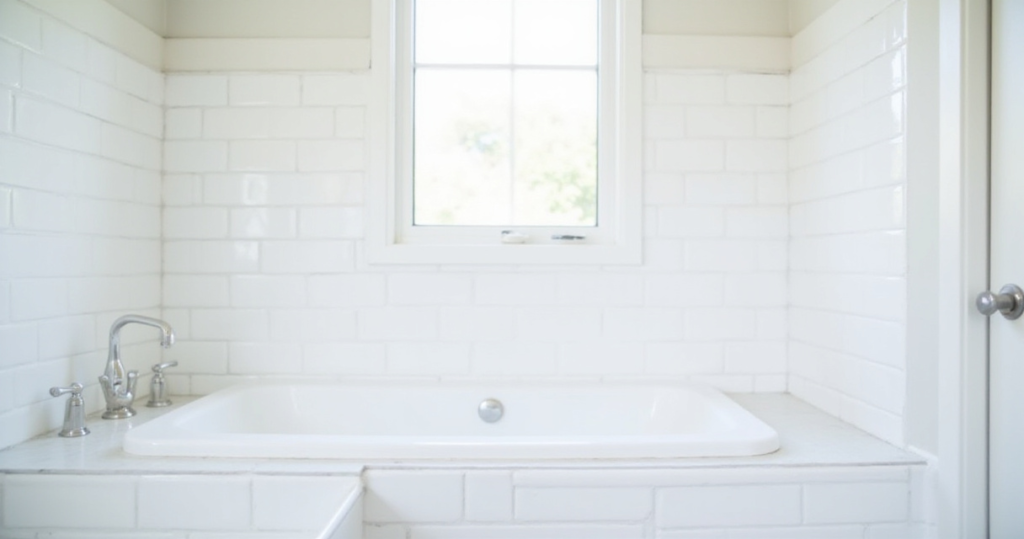The bathroom often hides in plain sight – a functional necessity rather than a celebrated space. Yet with thoughtful design choices, this utilitarian room can become your home’s most intimate retreat. Among all design elements, tiles offer the most transformative power, turning sterile spaces into personal sanctuaries through color, texture, and pattern.
As someone who has spent years studying how Latin American design traditions can enrich contemporary spaces, I’ve seen firsthand how the right tile can completely reimagine a bathroom. The perfect tile doesn’t just withstand water and wear – it tells a story, creates atmosphere, and reflects your unique aesthetic vision.
Here are 22 bathroom tile ideas that range from timeless classics to bold statements, each with the power to completely transform your space.
1. Classic subway tile: Timeless and Versatile
Subway tile’s enduring popularity stems from its clean lines and remarkable adaptability. This rectangular tile complements virtually any bathroom style – from farmhouse charm to sleek minimalism – while its typically glossy finish amplifies light in smaller spaces. Its affordability and widespread availability make it accessible for nearly any renovation budget.

While classic white remains the standard, today’s subway tiles come in countless variations. Consider soft sage green for a subtle organic feel, deep navy for dramatic contrast, or crackle-glazed finishes that add dimension and character. The grout you choose matters too – a contrasting color emphasizes the pattern’s geometric precision, while matching grout creates a more seamless look.
The inspiration for this collection struck when I visited a beautifully restored 1920s home in Mexico City, where original subway tile had been preserved and celebrated rather than replaced. The timeless quality of these century-old installations proves that good design transcends trends.
2. Large Format Tiles for a Seamless, Modern Look
Large format tiles (typically 12×24 inches or larger) create an expansive, contemporary feel that immediately modernizes any bathroom. Their minimal grout lines not only create a sleek aesthetic but also offer practical benefits – fewer grout lines mean less cleaning and less opportunity for mold and mildew growth. The visual expansiveness they create can make even modest bathrooms feel significantly larger.
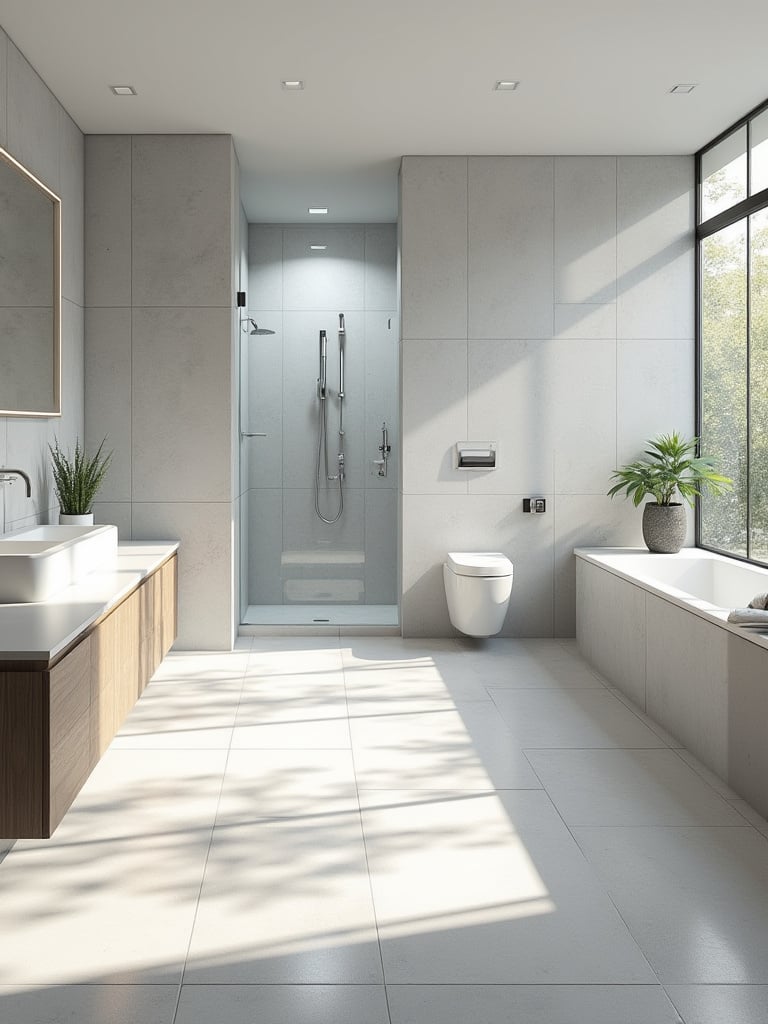
When considering large format tiles, remember that proper installation is crucial. The subfloor must be perfectly level, as any imperfections become magnified with larger pieces. While porcelain remains the most popular material choice due to its durability and moisture resistance, large format tiles now come in everything from natural stone to terrazzo-look finishes.
The craftsmanship in this collection tells a story of precision and restraint. In my work integrating traditional Latin American aesthetics with modern design, I’ve found that large format tiles provide the perfect neutral canvas for showcasing handcrafted accessories and textiles with cultural significance.
3. Make a Statement with Bold Patterned Tiles
Bold patterned tiles inject personality and energy into bathroom spaces that might otherwise feel clinical. Geometric designs, Moroccan-inspired motifs, and abstract patterns can transform an ordinary bathroom into a visual feast. The key is strategic placement – a fully patterned room can overwhelm, while a feature wall or floor creates impact while maintaining balance.

Consider scale carefully when selecting patterned tiles. Larger patterns can make small bathrooms feel cramped, while tiny patterns might get lost in expansive spaces. The color palette matters too – limit your pattern to 2-3 complementary colors for cohesion, or choose monochromatic patterns for subtle sophistication.
The artisans behind these designs began with centuries-old pattern traditions but reimagined them for contemporary spaces. I’ve worked with craftspeople throughout Latin America who hand-paint cement tiles using techniques passed down through generations, creating bathroom tile ideas that connect modern homes to rich cultural heritage.
4. Intricate Beauty: Designing with Mosaic Tiles
Mosaic tiles bring unparalleled versatility to bathroom design through their ability to conform to curved surfaces and create intricate patterns impossible with larger formats. Their small size (typically under 2 inches) allows for creative expression in shower niches, backsplashes, or feature walls. The increased number of grout lines also provides excellent slip resistance for wet areas.
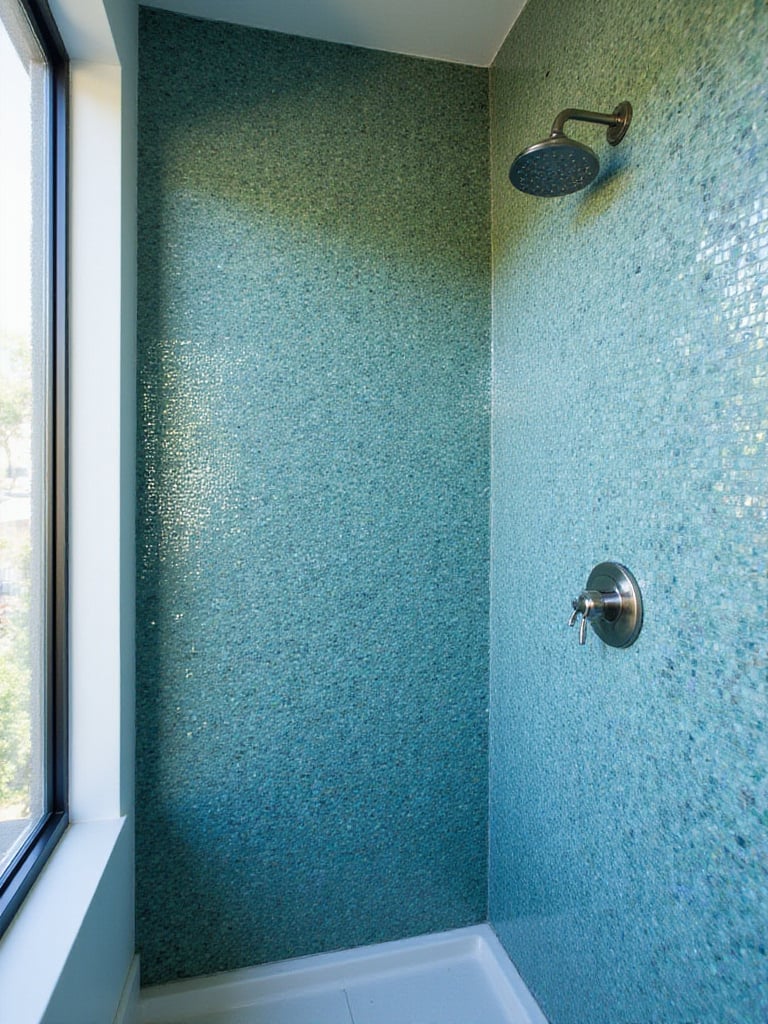
Available in glass, ceramic, stone, metal and countless other materials, mosaics can achieve virtually any aesthetic. Glass mosaics reflect light beautifully, brightening small spaces. Stone mosaics add organic texture and natural variation. Consider using mosaics as accents within larger tile installations – perhaps as a decorative band or to highlight architectural features.
What makes this design special is the way it honors ancient traditions while embracing modern applications. Mosaic artistry dates back thousands of years, with some of the most stunning examples found in Latin American colonial architecture, where European and indigenous design elements merged to create something entirely new.
5. Geometric Charm: Explore Hexagon Tile Designs
Hexagon tiles bring geometric interest to bathrooms without overwhelming the space. Their six-sided shape creates a honeycomb effect that feels both organized and organic – a perfect balance for bathroom design. While traditional hexagons measure 1-2 inches across, today’s options range from tiny mosaics to statement-making large formats.
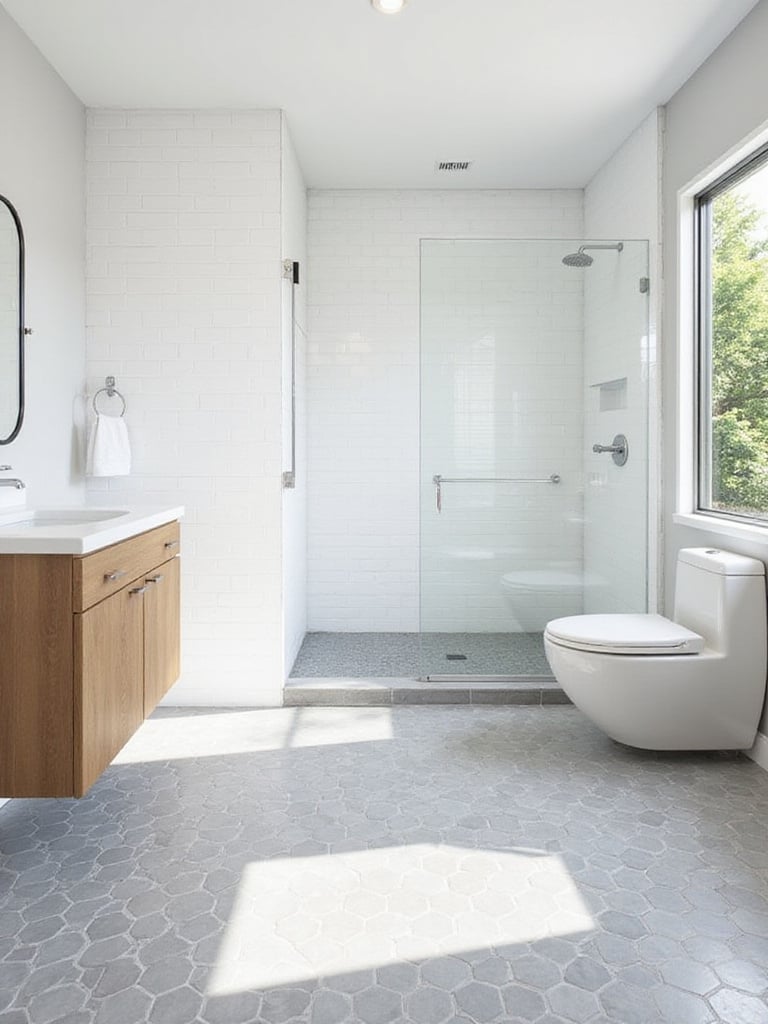
Color and material choices dramatically impact the final look. White hexagons with dark grout create classic contrast, while colorful variations can form gradient patterns or random distributions for playful energy. Consider carrying hexagons from floor to wall for cohesive design, or use them as an accent against simpler rectangular tiles.
The unexpected pairing that always works is hexagon floor tile with simple rectangular wall tile. This combination honors the hexagon as a focal point while preventing pattern overload. In my design practice, I often incorporate handcrafted Mexican hexagon tiles with simple white walls for a balance of cultural richness and clean modernity.
6. Warm Up Your Bathroom with Wood-Look Porcelain
Wood-look porcelain solves the seemingly impossible challenge of bringing wood’s warmth into moisture-rich bathrooms. Unlike real wood, which warps and deteriorates in humid environments, these porcelain tiles resist water damage while perfectly mimicking wood’s color variations, grain patterns, and even texture. They’re also significantly easier to maintain than their natural counterparts.

Today’s manufacturing techniques have created remarkably realistic options that capture everything from weathered barn wood to exotic tropical species. Consider plank sizes carefully – traditional narrow planks create a classic look, while oversized planks feel more contemporary. For installation, staggered patterns mimic real wood flooring, while herringbone or chevron patterns add architectural interest.
“Wood-look porcelain connects us to nature’s warmth while acknowledging the practical realities of bathroom environments. It’s not about imitation but about thoughtful adaptation.” – Design philosophy I share with clients
The environmental story behind this piece began with recognizing that sustainable design sometimes means choosing alternatives to natural materials. Quality wood-look porcelain can last decades without replacement, reducing resource consumption while still honoring our innate connection to natural textures.
7. Elevate Luxury with Elegant Marble Tiles
Marble’s natural veining and subtle color variations bring inherent luxury to bathroom spaces. Each piece tells a geological story thousands of years in the making, with patterns as unique as fingerprints. This natural variation creates visual depth that manufactured tiles simply cannot replicate. From classic Carrara with its subtle gray veining to dramatic Calacatta with bold gold streaks, marble instantly elevates any bathroom.
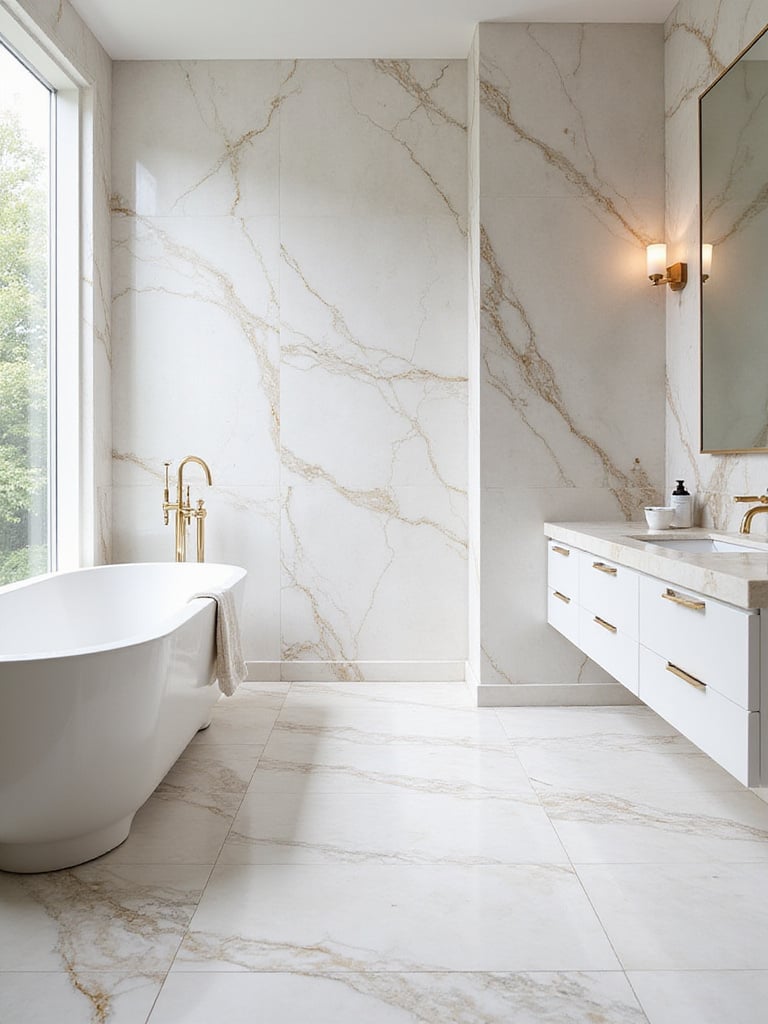
While beautiful, marble requires special consideration. As a porous natural stone, it needs regular sealing to prevent staining and etching from acidic substances. For those concerned about maintenance, consider marble-look porcelain, which captures the aesthetic without the vulnerability. Alternatively, reserve real marble for less water-prone areas like accent walls while using more durable materials in heavy splash zones.
The quality becomes evident after years of use when marble develops a subtle patina that adds character rather than looking worn. This living quality connects to Latin American design traditions that celebrate materials that age gracefully rather than trying to maintain a perpetual newness.
8. Vintage Vibes: The Sweetness of Penny Tiles
Penny tiles, with their distinctive small circular shape, instantly evoke early 20th-century charm. Popular during the Victorian and Art Deco eras, these tiny tiles (typically ¾-inch in diameter) bring nostalgic appeal while offering practical benefits for bathrooms – their numerous grout lines provide excellent slip resistance for wet floors.
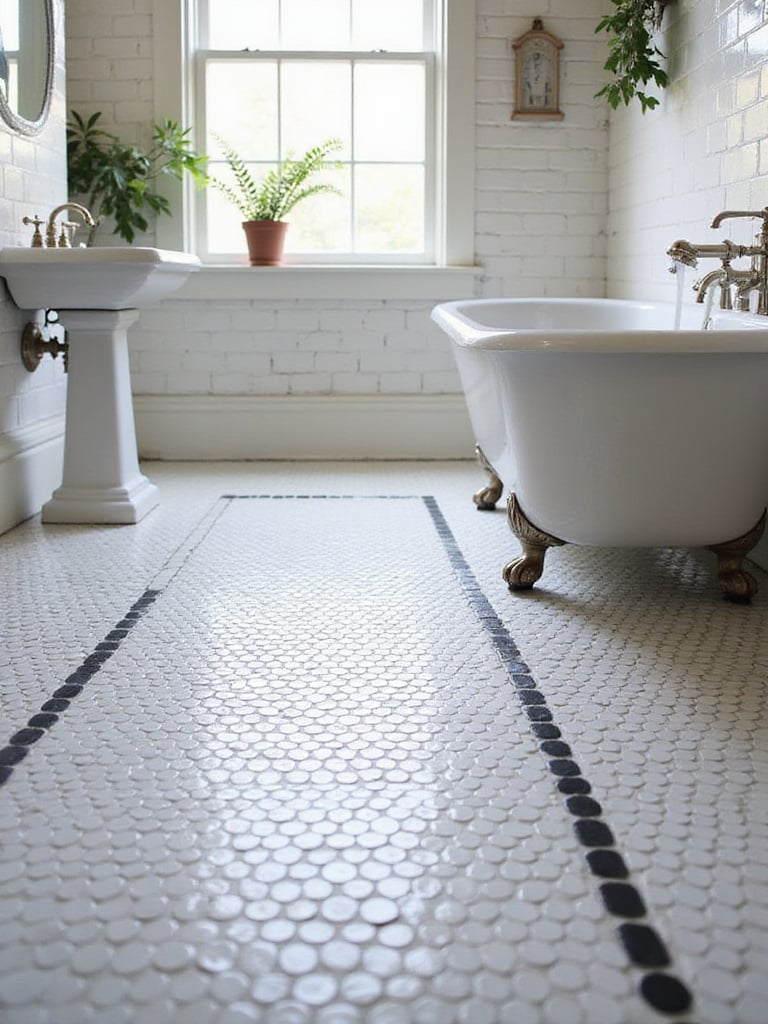
Classic black and white remains the most recognizable application, but contemporary penny tiles come in virtually every color and material. Consider unexpected color combinations or creating simple patterns through strategic placement. The small size makes them ideal for curved surfaces like shower niches or around pedestal sinks where larger tiles would require awkward cuts.
The revival of this classic form comes with a twist as today’s designers use penny tiles in fresh ways – creating ombré effects, mixing glossy and matte finishes, or combining them with contrasting rectangular tiles. This bathroom tile idea beautifully bridges historical reference and contemporary expression.
9. Dive In: Unique Fish Scale (Fan) Tiles
Fish scale tiles (also called fan or scallop tiles) bring fluid, organic movement to bathroom surfaces. Their curved shape evokes water itself – perfect for a space dedicated to cleansing. The overlapping pattern creates visual rhythm that draws the eye across the surface, making them ideal for feature walls or shower surrounds.
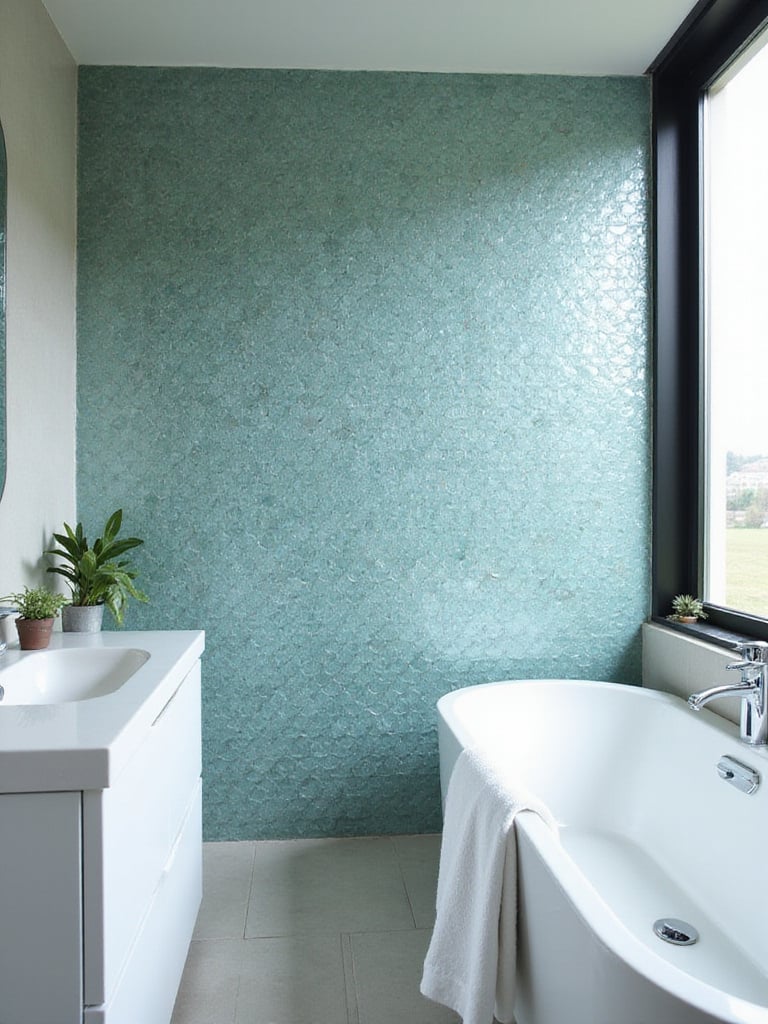
These distinctive tiles work in various materials, from ceramic and porcelain to glass and natural stone. Color choice dramatically impacts the final effect – blues and greens emphasize the aquatic connection, while neutrals create subtle texture, and metallics add unexpected glamour. Consider playing with installation direction to create different effects – horizontal scales feel more traditional, while vertical application creates dramatic movement.
The unexpected color story emerging this year embraces terracotta and earthy clay tones for fish scale tiles – a departure from expected blues and greens that connects to indigenous pottery traditions throughout Latin America. These warm hues transform fish scales from purely aquatic references into something more grounded and unexpected.
10. Embrace Imperfection: The Rustic Beauty of Zellige Tiles
Zellige tiles capture the soulful imperfection of handcraftsmanship through their slightly irregular edges, subtle color variations, and dimensional surfaces that catch light in unpredictable ways. Originating in Morocco, these clay tiles are hand-cut and glazed using centuries-old techniques, bringing authentic artisanal character to contemporary bathrooms.
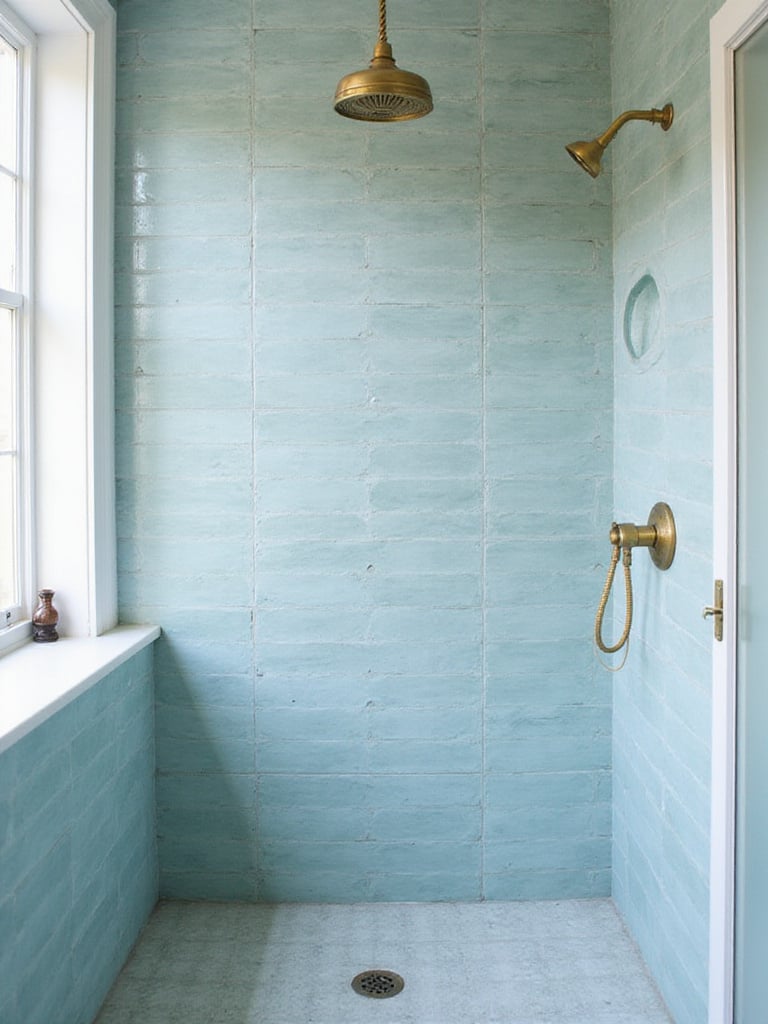
The distinctive shine of Zellige comes from its traditional glaze application – multiple layers that create a depth and luminosity machine-made tiles cannot replicate. While white and neutral tones remain popular, jewel-toned Zellige in emerald green, sapphire blue, or ruby red creates dramatic impact. Consider using these tiles for shower surrounds or vanity backsplashes where their reflective quality will interact beautifully with water and light.
The cultural heritage preserved in each piece includes techniques that remind me of traditional Mexican talavera pottery – both traditions celebrate the human touch rather than perfect uniformity. This connection between North African and Latin American craft traditions reveals how artisanal wisdom transcends geography.
11. Reflecting Light: The Sparkle of Glass Tiles
Glass tiles transform bathroom lighting through their unique translucent properties. Unlike opaque materials, glass captures, filters, and reflects light, creating a luminous quality that can make even small bathrooms feel more expansive and bright. This reflective quality makes them particularly valuable in bathrooms with limited natural light.
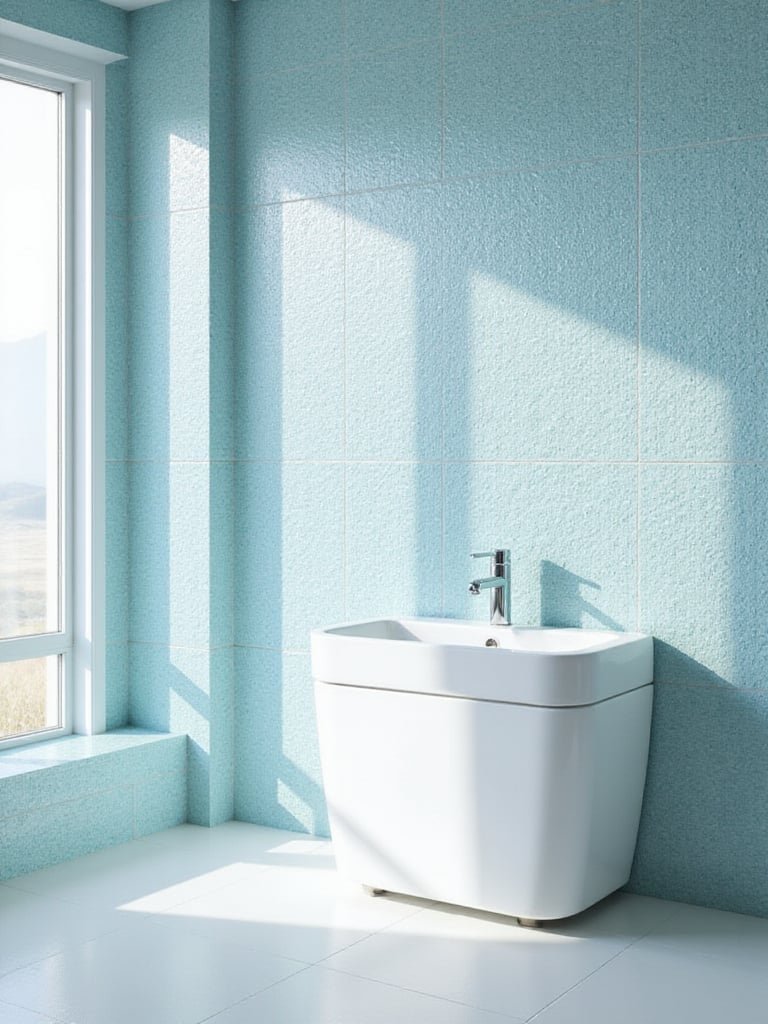
Available in countless colors, finishes, and sizes, glass tiles offer tremendous design flexibility. Clear glass amplifies light dramatically, while frosted glass diffuses it more gently. Iridescent finishes create rainbow-like effects as lighting conditions change throughout the day. For practical durability, look for glass tiles specifically manufactured for wet areas, with proper backing and edge treatment to prevent water infiltration.
The magic of this piece lies in its ability to transform ordinary bathroom light into something almost magical. In my design work, I often pair glass tile with simple sconces to create dramatic lighting effects that change throughout the day – a technique inspired by how natural light filters through colored glass in colonial Latin American architecture.
12. Bring Nature Inside with Natural Stone Tiles
Natural stone tiles connect bathrooms to the earth itself through materials formed over millions of years. Each piece carries unique mineral patterns, color variations, and subtle textures impossible to duplicate in manufactured products. This inherent variation creates bathrooms with depth, character, and timeless appeal that transcends passing trends.
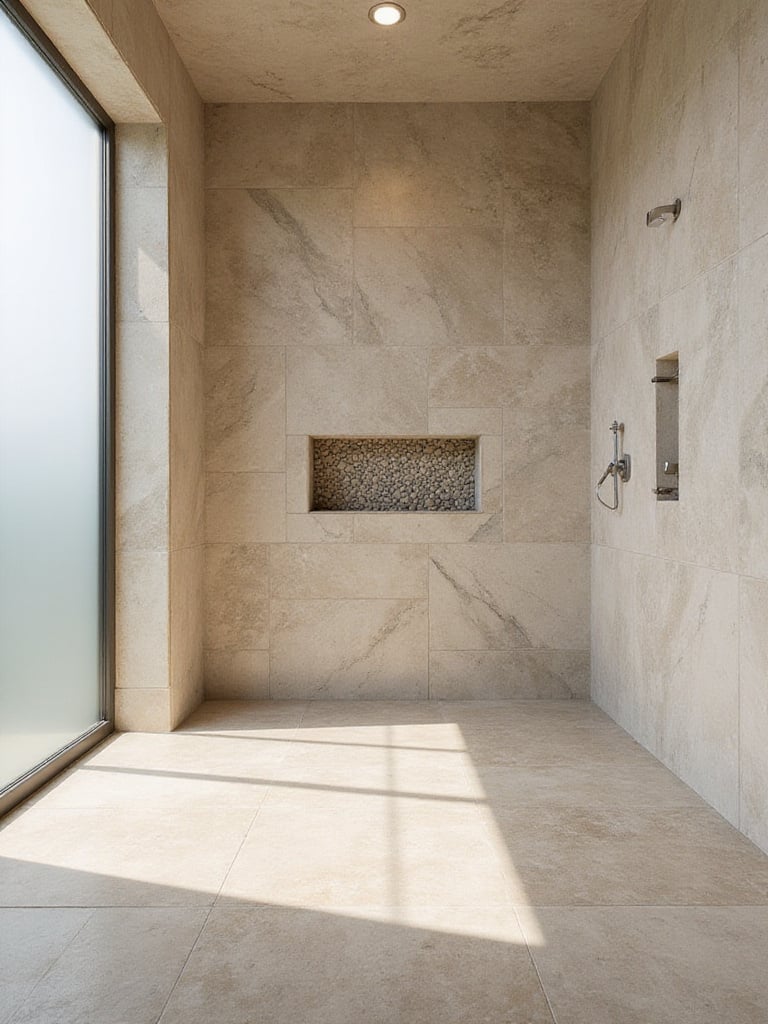
Different stones offer distinct personalities. Marble brings elegant veining and luminosity. Granite provides exceptional durability with crystalline depth. Slate offers earthy texture with dramatic color variation. Travertine creates warm, rustic appeal with its natural pitting. Consider how each stone’s characteristics align with your maintenance tolerance – some require more frequent sealing and careful cleaning than others.
- Marble: Elegant veining, available in many colors, requires regular sealing
- Granite: Extremely durable, crystalline appearance, resistant to staining
- Slate: Naturally textured surface, dramatic color variation, excellent slip resistance
- Travertine: Warm tones, natural pitting creates distinctive texture, requires filling
- Limestone: Subtle, uniform appearance, softer than marble or granite
If you’ve struggled with similar rooms before, natural stone might be the missing element. Its authentic connection to the earth grounds bathroom design in something real and substantial. This bathroom tile idea works particularly well in spaces that feel too clinical or manufactured.
13. Speckled Sophistication: Discovering Terrazzo Tiles
Terrazzo brings playful sophistication through its distinctive speckled appearance – chips of marble, quartz, glass, or other materials suspended in a cement or resin base. Originally developed as a way to use stone scraps, terrazzo has evolved into a design statement that works beautifully in contemporary bathrooms, offering visual texture without overwhelming pattern.

Modern terrazzo tiles offer tremendous design flexibility. The background color, chip size, chip material, and chip density can all be customized to achieve looks ranging from subtle and refined to bold and graphic. Large-format terrazzo tiles minimize grout lines for a more seamless appearance, while smaller formats allow for more traditional installation patterns.
For those worried about maintenance, terrazzo offers remarkable durability. Unlike some natural stones, quality terrazzo resists staining, scratching, and moisture damage when properly sealed. This practical resilience explains its historic use in high-traffic commercial spaces before becoming a residential design favorite.
14. Urban Edge: Industrial Brick-Look Tiles
Brick-look tiles bring architectural character and industrial edge to bathroom spaces without the practical concerns of actual brick. Made from porcelain or ceramic, these tiles replicate brick’s texture and color variation while providing the water resistance essential for bathroom applications. The result is a bathroom with urban sophistication and unexpected warmth.

When incorporating brick-look tiles, consider scale and color carefully. Traditional brick proportions create authentic character, while longer, thinner formats offer a more contemporary interpretation. Color options range from classic reds and warm terracottas to whitewashed finishes, charcoal grays, and even unexpected hues like navy or forest green. For a more refined look, choose tiles with subtle texture rather than heavily distressed finishes.
When clients ask us about balancing style with comfort, brick-look tiles often provide the perfect solution. They add character without sacrificing functionality – a balance I discovered while renovating historical buildings in Mexico City where preserving brick character while creating modern bathrooms required creative compromise.
15. A Modern Twist: Tiling Vertically for Height
Vertical tile installation transforms bathroom proportions by drawing the eye upward, creating a perception of greater ceiling height and spatial volume. This simple orientation shift can make modest bathrooms feel significantly more expansive and architecturally interesting without changing the actual dimensions.

This technique works particularly well with rectangular tiles like subway or plank formats. The vertical lines create rhythm and movement that energize the space. Consider carrying the vertical orientation throughout the bathroom for cohesion, or use it strategically in areas you want to emphasize – perhaps in the shower or behind the vanity. The contrast between vertical tile and horizontal countertops or fixtures creates dynamic visual tension.
The designer’s secret here is to use vertical tiling to frame key bathroom elements. In Latin American design, vertical orientation often emphasizes architectural features like arched doorways or niches – a technique that translates beautifully to contemporary bathroom tile ideas.
16. Dramatic Contrast: Pairing Light Tiles with Dark Grout
Light tiles with dark grout create graphic definition that transforms simple tiles into statement pieces. This high-contrast approach highlights the geometric pattern of the tile layout while adding architectural interest to even the most basic tile shapes. The result is a bathroom with clear visual structure and designer-level sophistication.

This technique works particularly well with white subway tiles and charcoal or black grout, creating a timeless yet contemporary look. For a more subtle effect, consider light gray grout with white tile, or taupe grout with cream tile. The contrast level you choose affects the overall feel – sharper contrasts create more drama, while softer contrasts feel more refined and understated.
The styling mistake most people make is choosing grout color as an afterthought. In reality, grout comprises a significant visual portion of any tiled surface and deserves careful consideration. This bathroom tile idea demonstrates how a simple material choice can completely transform the look of standard tiles.
17. Subtle Definition: Using Light Grout with Dark Tiles
Dark tiles with light grout reverse the typical high-contrast formula, creating a softer, more subtle definition that highlights tile shapes without the graphic boldness of dark grout on light tiles. This approach adds dimensional interest while maintaining a sophisticated, understated elegance perfect for creating depth without overwhelming the space.
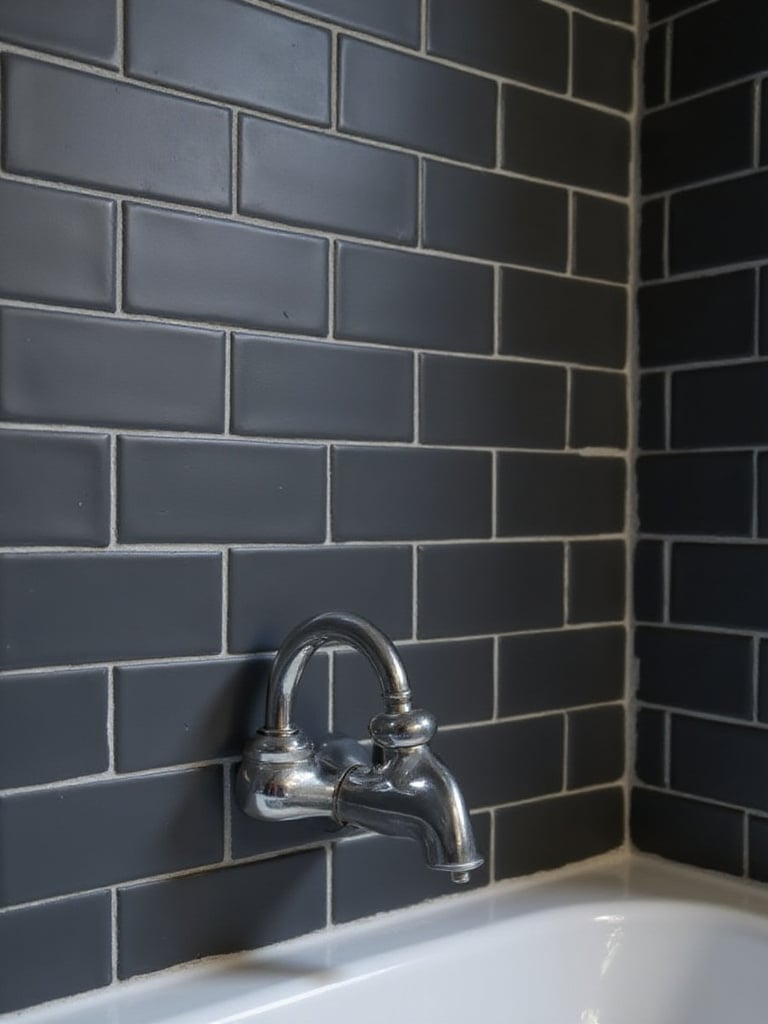
This technique works beautifully with charcoal, navy, forest green, or black tiles paired with light gray, taupe, or even white grout. The lighter grout creates a delicate outline around each tile, emphasizing its shape while brightening the overall effect. Consider this approach for bathrooms where you want visual texture without high drama – perhaps in spa-inspired spaces focused on relaxation.
The visual weight balances perfectly when dark tiles provide substance while light grout creates breathing room. This balance reflects design principles I observed in colonial Mexican architecture, where dark volcanic stone was often outlined with light mortar to create visual rhythm in massive structures.
18. Classic Detail: Adding Tile Wainscoting
Tile wainscoting brings architectural character to bathrooms while serving the practical purpose of protecting walls from water damage. Typically installed to a height of 36-48 inches, this partial wall treatment creates visual division that can make ceilings appear higher while adding traditional charm to contemporary spaces.
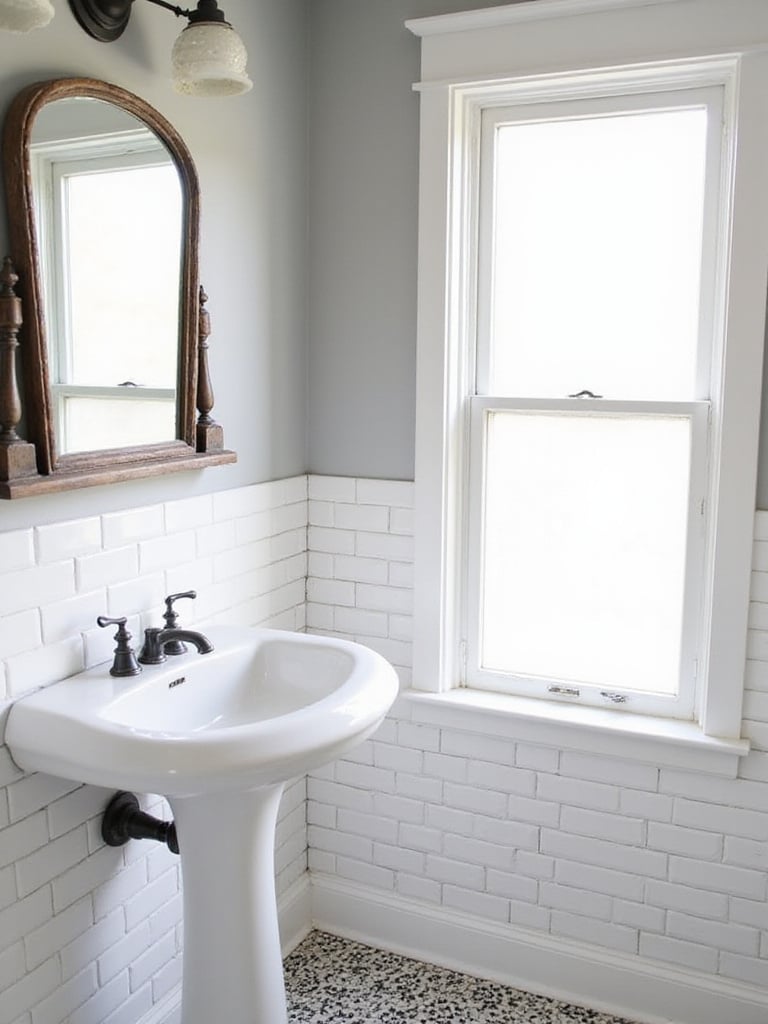
For classic elegance, consider subway tile, beadboard-inspired ceramic, or marble wainscoting with a coordinating cap piece. For more contemporary applications, large-format rectangular tiles installed vertically create a modern interpretation of this traditional technique. The wall space above the wainscoting provides an opportunity for contrast through paint color, wallpaper, or even a different tile treatment.
Many homeowners wonder how to achieve the look of custom millwork without the moisture concerns in bathroom environments. Tile wainscoting offers the perfect solution – architectural detail with superior water resistance and durability compared to wood alternatives.
19. Accent Your Shower: Tiling the Niche
Shower niches present perfect opportunities for accent tiles that add personality and visual interest. These practical recesses keep shower essentials organized while creating design moments that can tie together your bathroom’s color story or introduce unexpected elements that might overwhelm larger surfaces.
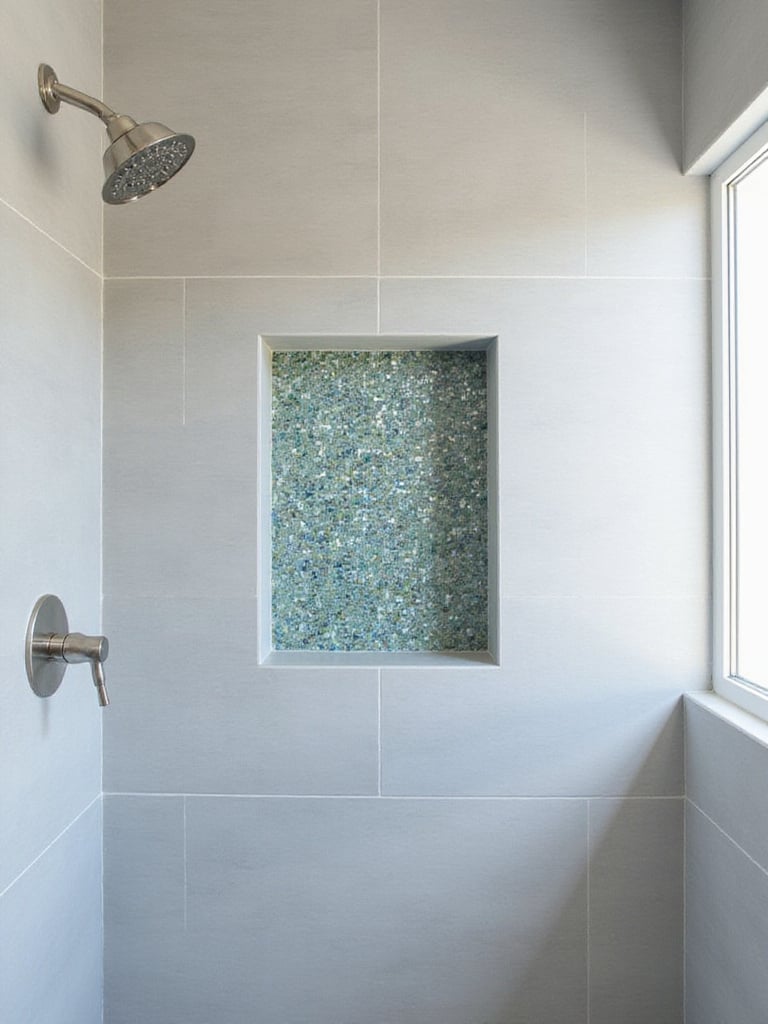
Consider materials that create textural contrast with your primary shower tile – perhaps glass mosaic within a ceramic tile shower, or marble within porcelain surrounds. Alternatively, use the same tile as the main shower but in a different pattern or orientation. For a cohesive look, choose accent tiles that pick up colors from elsewhere in the bathroom – perhaps from the vanity, floor, or accessories.
The finishing touch that elevates the entire look is thoughtful lighting. Consider recessed waterproof lighting above or within the niche to highlight your accent tile. This bathroom tile idea transforms a purely functional element into a design feature worth showcasing.
20. Elegant Pattern Play: The Herringbone Layout
Herringbone pattern transforms ordinary rectangular tiles into dynamic surfaces through its distinctive V-shaped arrangement. This classic pattern brings movement and sophistication to bathroom surfaces without requiring specialty tiles – standard subway or plank tiles can be arranged in herringbone for instant elegance.
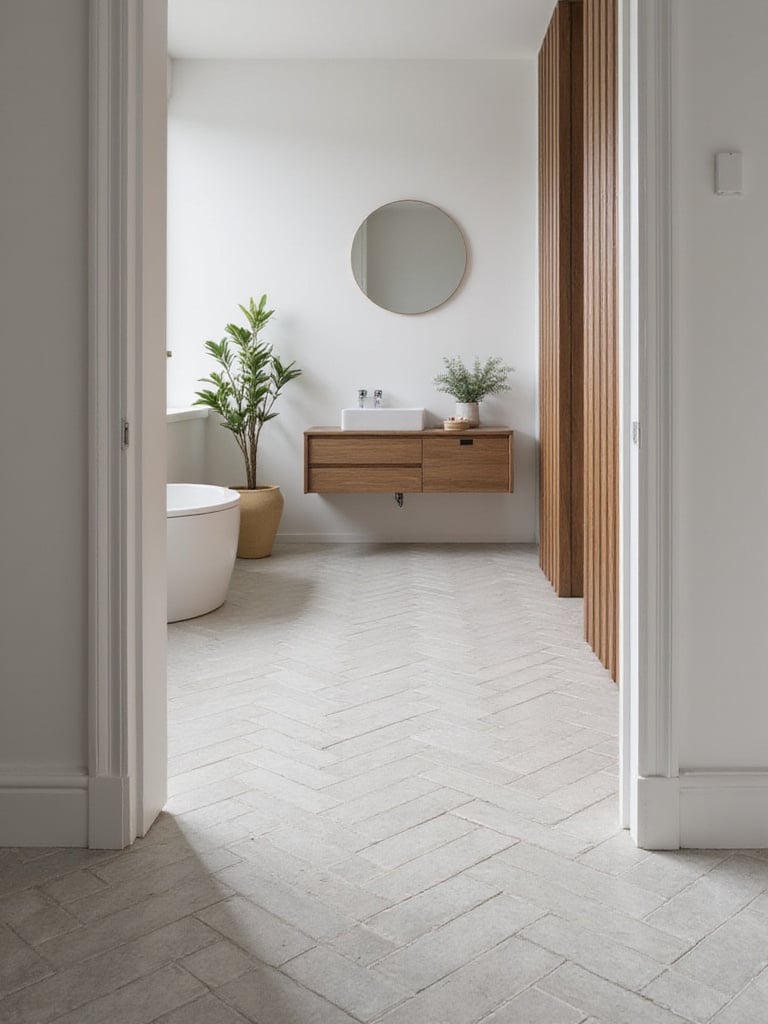
While traditional herringbone uses a 45-degree angle, contemporary interpretations often use 90-degree arrangements for a more modern feel. Consider scale carefully – smaller tiles create more intricate patterns with greater visual density, while larger formats create bolder, more graphic impact. This pattern works beautifully on floors, shower walls, or as a feature behind vanities.
Beyond the obvious placement, consider using this for unexpected applications like ceiling treatments in shower areas or wrapping around curved walls. The herringbone’s directional quality can guide movement through the bathroom space – a principle borrowed from grand Latin American haciendas where tile patterns often directed visitors through complex architectural spaces.
21. Clean Lines: The Modern Stack Bond Pattern
The stack bond pattern arranges tiles in perfect grid alignment – each tile stacked directly above, below, and beside its neighbors without the offset of traditional running bond patterns. This creates a clean, architectural look with strong vertical and horizontal lines that brings order and contemporary simplicity to bathroom surfaces.

This pattern particularly suits modern and minimalist bathroom designs. Its geometric precision complements architectural spaces with strong lines and right angles. Consider using contrasting grout to emphasize the grid, or matching grout for a more seamless effect. While this pattern works with nearly any tile shape, it particularly enhances the clean lines of large-format rectangular tiles.
While designed for the living room, we’ve seen creative uses in bathrooms that challenge conventional wisdom. The stack bond pattern traditionally appeared in commercial and industrial spaces, but its migration to residential bathrooms demonstrates how design elements can be successfully recontextualized in unexpected environments.
22. Creative Combinations: Mixing Different Tile Styles
Mixing different tile styles creates truly personalized bathrooms that tell visual stories through contrasting textures, scales, and patterns. This approach allows you to incorporate multiple bathroom tile ideas within a single cohesive design – perhaps combining the timeless appeal of subway tile with the graphic punch of geometric patterns or the organic texture of natural stone.
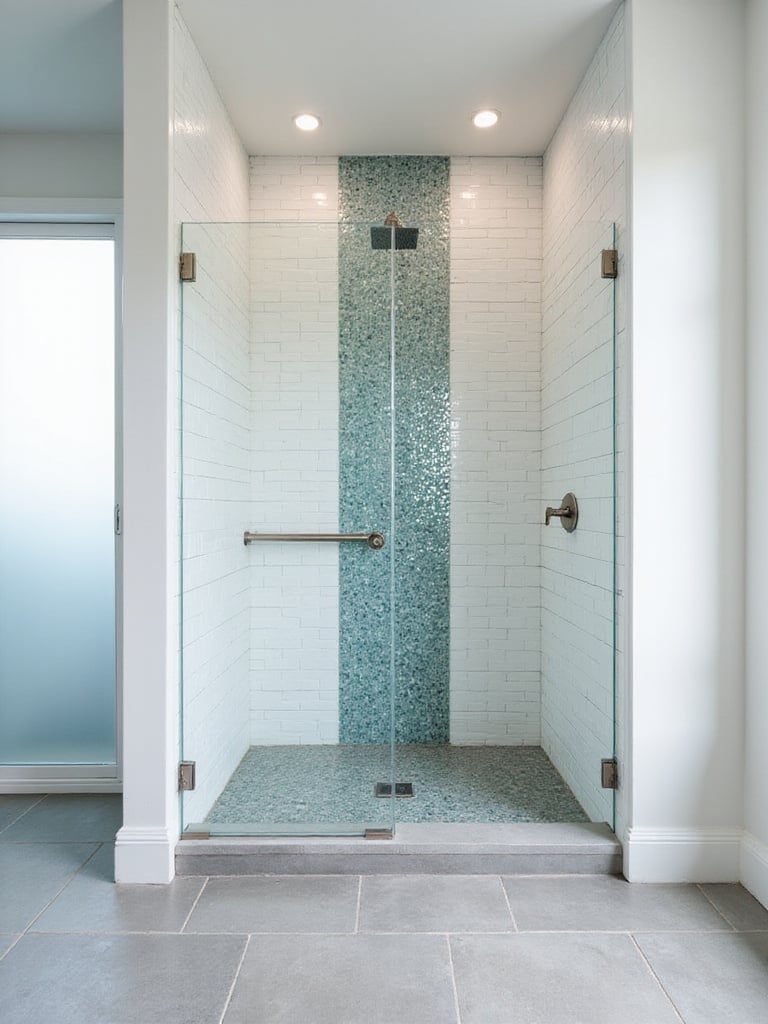
Successful mixing requires thoughtful planning. Establish a consistent color palette that connects different tile styles. Vary scale intentionally – perhaps large-format floor tiles with intricate mosaic accents. Create clear purpose for each tile type – floor vs. wall, wet areas vs. dry, feature areas vs. background. Limit your selection to 2-3 different tile styles to prevent visual chaos.
Beyond aesthetics, the ecological impact matters because thoughtful combinations can reduce waste. Using specialty tiles as accents rather than throughout the entire bathroom reduces cost while creating more sustainable design. This approach honors the Latin American tradition of resourcefulness – using precious materials strategically for maximum impact.
Conclusion
The bathroom tile ideas we’ve explored demonstrate how this humble material can transform utilitarian spaces into personal sanctuaries. From classic subway to dramatic patterns, from tiny penny rounds to expansive large formats, tiles offer endless possibilities for expressing your unique style while meeting the practical demands of bathroom environments.
The most successful bathroom designs consider both aesthetics and functionality – the visual impact you desire alongside the durability and maintenance requirements you can realistically manage. Whether you’re drawn to the timeless elegance of marble, the handcrafted charm of Zellige, or the graphic boldness of geometric patterns, there’s a tile solution that can bring your bathroom vision to life.
As you plan your bathroom transformation, remember that tiles aren’t just surface coverings – they’re design elements that influence how you experience your most private space each day. Choose tiles that not only please your eye but also nurture your spirit, creating a bathroom that truly feels like an extension of yourself.
